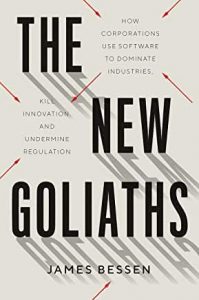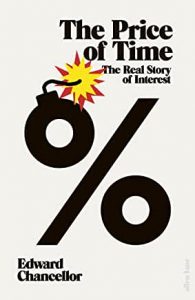James Bessen’s The New Goliaths is one of my books of the year so far (with a fashionably chatty subtitle). Indeed, I’d been looking forward to it because I liked his previous one, Learning By Doing, so much. Based on his impressive research on technology over a number of years, and on his prior experience as the founder of a successful early digital startup, the core of the argument is that a small number of (generally) large companies have built IT systems that can manage immense complexity in their operations. Sophisticated software and massive flows of data enable them to co-ordinate in previously unimaginable ways, delegating decisions to where the information can go. The complexity – say of a new model of software-laden car or a major retailer’s logistics system – increases the cost of entry for potential competitors. The Goliaths are to be found not just in ‘Big Tech’, but in many sectors of the economy.
What’s more, “The investment in software is only part of the total investment in these systems. The entire technology investment that firms make in these proprietary systems goes well beyond software code to include data, workforce skills and investments in alternative organizational structures.” An example used throughout the book is Walmart – which McKinsey found accounted for a substantial proportion of the US 1990s productivity boost. Somewhat counter-intuitively, at least for those who see Big Tech as the main competition problem, Bessen sees Walmart as the unassailable incumbent in US retail, whereas Amazon is the one example of successful entry, and one offering a platform to other retailers.
This dynamic, of superstar firms in many industries from retail to autos to finance with a widening productivity advantage, has consequences for income inequality: the workers in those firms are paid more because they gain invaluable experience simple by working in the superstar companies, so wages are dispersing within sectors. The skills are scarce because you have to work for a big, sophisticated complex firm to get the skills, which are thus in short supply. It has led to less dynamism – fewer entries and exits in many markets. Small firms simply can’t match the spending on R&D of the big ones: one example given is voice recognition software, where pioneer Nuance was a massive commercial success, but still couldn’t match the spending of big firms: Amazon (again) has more than 10,000 engineers working on Alexa products, more than ten times the number Nuance had at its peak. “Proprietary information technology is exacerbating economic and social devisions. It is widening the gaps between the pay of workers at different firms. It is leading to greater segregation of skill groups across firms and cities.”
The complexity dynamic has implications too for competion policy – which becomes challenging, because after all the superstars generally offer great services – and regulation more broadly – because the information asymmetry between company and regulator grows ever wider.
So what to do? The book advocates for mandating open standards, morecompulsory licensing, and for reforming IP law to tilt the incentives for big companies to do more voluntary unbundling of their services, clamping down on worker non-compete agreements to spread skills. All excellent, and ultimately inevitable policies, as the inequalities are socially and politically unsustainable. But there’s much devil in the detail, and there will be massive lobbying against change. So this is a political struggle rather than a technocratic one.
But that’s to wander off into the future. I highly recommend The New Goliaths. It synthesizes a growing body of research into how firms use technology, how that interacts with organisational structures and markets, and what the consequences are. It’s also really well-written, with lots of examples and a grounded understanding of the realities and limits of technology policy.



